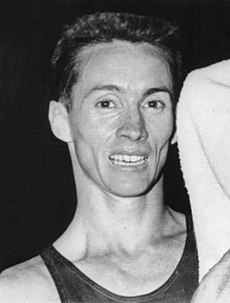Al Lawrence (distance runner)
 Lawrence in 1960 | ||||||||||||
| Personal information | ||||||||||||
|---|---|---|---|---|---|---|---|---|---|---|---|---|
| Full name | Allan Cleave Evan Lawrence | |||||||||||
| Born | 30 July 1930 Punchbowl, New South Wales, Australia | |||||||||||
| Died | 15 May 2017 (aged 86) Houston, Texas, U.S. | |||||||||||
| Height | 5 ft 7 in (170 cm) | |||||||||||
| Weight | 134 lb (61 kg) | |||||||||||
| Sport | ||||||||||||
| Sport | Athletics | |||||||||||
| Event | 5000 m – marathon | |||||||||||
| Club | Botany Harriers, Sydney Randwick Botany Harriers, Sydney | |||||||||||
| Achievements and titles | ||||||||||||
| Personal best(s) | 5000 m – 13:54.2 (1957) 10,000 m – 28:53.59 (1956) Mar – 2:26:43 (1953)[1][2] | |||||||||||
Medal record
| ||||||||||||
Allan Cleave Evan Lawrence (9 July 1930 – 15 May 2017) was an Australian long-distance runner. He won a bronze medal for Australia in the 1956 Summer Olympics.[3]
Lawrence was born in the Sydney suburb of Punchbowl. He competed for Australia in the 1956 Summer Olympics held in Melbourne, Australia in the 10,000 metres where he won the bronze medal, clocking 28:53 (nearly 30 seconds faster than he had ever run before).[1] He also qualified for the 5,000 metre final, but did not compete due to a strained leg muscle.[4]
Two years later, he came to the University of Houston to run for the Cougars. In 1959–60, he captured consecutive NCAA cross-country titles and followed each with an AAU XC win.[5] In 1960, he set a world indoor two-mile record with 8:46. Six days later, he won the AAU three-mile with another world record of 13:26. He was the only male runner to win both the NCAA and AAU Cross Country individual championship in the same year until 1992 (Bob Kennedy).
At the 1960 Olympic games in Rome, he placed fourth in the 5,000 metre heats, did not finish the 10,000 metres and placed a disappointing 54th in the marathon in 2:37.[1]
During his career, he broke over 10 Australian records from 2 miles to 10,000m and was the first Australian to break 14 minutes for 5000m and 30 and 29 minutes for 10,000m.[citation needed]
Lawrence returned to America where he became an American citizen in the early 1980s. He formed the Al Lawrence Running Club in Houston, which remains strong today. He co-authored 3 books with Mark Scheid, "The Self-Coached Runner", "The Self-Coached Runner II", "Running and Racing after 35" and an Autobiography "To Olympus and Beyond" (A Story of Life, Sport, and Love on Four Continents)
References
- ^ a b c "Allan Lawrence Bio, Stats, and Results". Sports-Reference. Archived from the original on 17 April 2020. Retrieved 18 May 2017.
- ^ Allan Lawrence. trackfield.brinkster.net
- ^ "Allan Lawrence 1930 – 2017". Australian Olympic Committee. 16 May 2017. Retrieved 18 May 2017.
- ^ "Lawrence Not to Run in 5000 Final". Google News. The Age. 18 November 1956. p. 11. Retrieved 18 May 2017.
- ^ Brown, Gwilym (5 December 1960). "A Double Double For Allen". Sports Illustrated Vault. Archived from the original on 4 June 2011. Retrieved 18 May 2017.
External links
![]() Media related to Al Lawrence (distance runner) at Wikimedia Commons
Media related to Al Lawrence (distance runner) at Wikimedia Commons
- Allan Lawrence at the Australian Olympic Committee
- Allan Lawrence at Olympics.com
- Al Lawrence at Olympedia (archive)